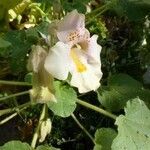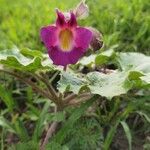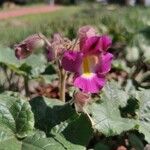Densely glandular-pubescent annual, beginning to bloom when only 1–2 dm, but becoming coarse, freely branched, and sprawling-ascending, to ca 6 dm tall and 2 m wide; lvs long-petioled, subrotund to reniform-cordate, irregularly sinuate to entire, the later ones to 25 cm; racemes mostly 8–20-fld; cal 1 cm or more, somewhat accrescent, but deciduous; cor 3.5–5.5 cm long and wide, dull whitish or yellowish, mottled and spotted with purple, or golden-yellow and marked with vermilion; fr 1–2 dm. A common weed in much of s. and c. U.S., frequently in cattle feed-lots, native perhaps as far n. as Ind., cult. for its curious frs (used as pickles) and occasionally escaped as far n. as Minn. and Me. (Martynia l.)



